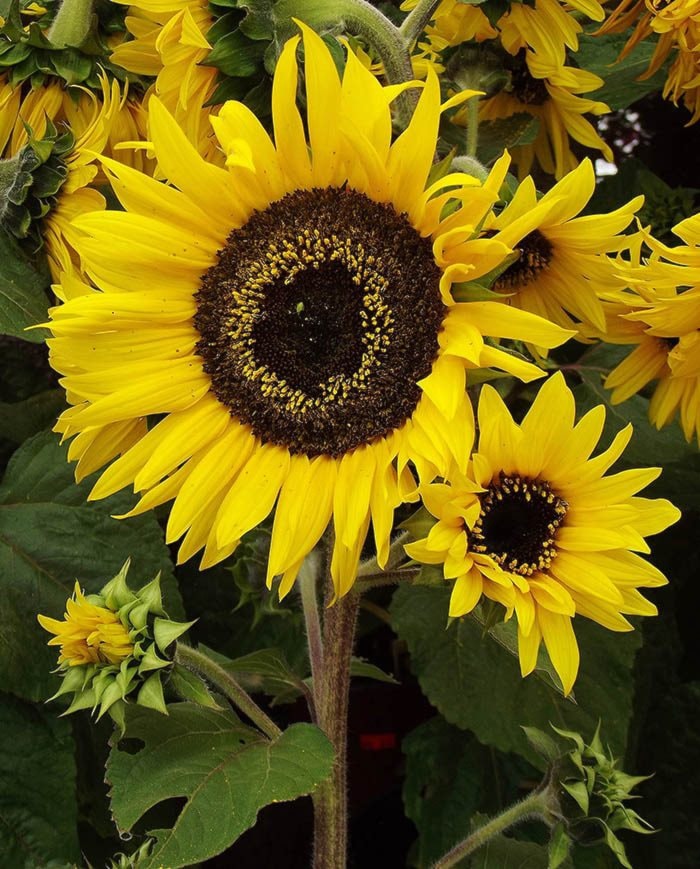I am a little embarrassed to reveal that the inspiration for this article came from a bathroom read – specifically the back cover of this year’s West Coast seed catalogue.
The caption “help the planet by planting more sunflowers” caught my attention and by the time I had gone through the 10 points that followed. I was really impressed. Don’t get me wrong, I like sunflowers, but my grade school addiction to the seeds and my admiration for those giant specimens at the community garden was about as far as my imagination took me.
What I didn’t know was how versatile this plant is in terms of potential uses and the benefits it provides average gardeners like myself.
The history of the sunflower (Helianthus annuus) goes back to 3000 B.C., when the Hopi and Navaho of New Mexico and Arizona cultivated it as a food crop with seeds ranging from white, red and black.
It was brought back to Europe in the late 16th Century by Spanish explorers, but the plant’s real renaissance occurred in 1830s Tsarist Russia, where it underwent intensive breeding to create oil-bearing and eating types, many of which (‘Russian Mammoth’) are still available to this day.
Of course, we have to give it a cultural nod, as this humble flower was the inspiration for many of Van Gogh’s iconic paintings – most of which were painted as gifts for fellow impressionist, Paul Gauguin.
Then there are the health benefits it provides; 100 grams of shelled sunflower seeds provides 42 per cent protein, 36 per cent dietary fiber, at least 23 per cent Vitamin B, 100 per cent Vitamin E of your daily value needs, and the phytosterols they contain helps to lower blood cholesterol levels.
But their presence in our gardens makes an even bigger impact, as they attract pollinators from great distances and provide both native and domestic bees with a valuable food source.
Beneficial insects such as ladybugs (which eat those nasty aphids) are also attracted by sunflowers, and even our drier summers can’t put a damper on things, as they are quite drought resistant.
You can plant oil types (such as ‘Peredovik’) or even the edible seed varieties, such as ‘Titan’ and ‘Giganteus,’ and just leave them to ripen and dry in the garden, after which many of our winter birds (chickadees) will feast on them.
Sunflowers also make great cuts for floral arrangements and come in a wide variety of colours for this purpose.
A few choice selections include ‘Teddy Bear’ (chubby double flowers), ‘Velvet Queen’ (burgundy red), ‘Autumn Beauty’ (yellow to bronze) and ’Lemon Queen’ (pale yellow).
On a more serious note, Sunflowers are grown to absorb and extract heavy metals, such as lead and arsenic, from contaminated soils and are being trialed at Fukushima and Chernobyl as a means of extracting strontium and caesium from ground water affected by those nuclear catastrophes.
Then there are the multiple everyday uses of this versatile plant, including biofuel (even the hulls can be burned), healthy cooking oil, latex and animal feed.
That is quite a resume for such a humble plant, which means that it should have a place in all of our gardens.
Growing sunflowers really isn’t that hard provided you follow a few simple rules. They are best sown directly anytime from mid April through to late May. They prefer good drainage and sun, with plenty of compost in the soil and when the plants are a foot tall, water them with one teaspoon of borax (boron) dissolved in 1.5 cups of water spread over 15 inches – as this will give you really big seeds.
– By Mike Lascelle, a local nursery manager and gardening author (hebe_acer@hotmail.com).
